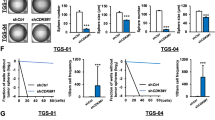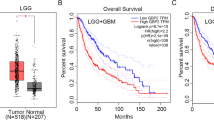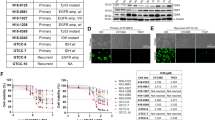Abstract
We have characterized the expression and activity of the cell cycle regulatory machinery and the organization of the cytoskeleton of the p16Ink4a-deficient astrocytoma cell line, U343 MG-a (U343), following retinoic acid (RA) treatment. RA causes cell cycle arrest at low cell density and significant morphological changes in U343 cells, reflected by reorganization of the intermediate filament, GFAP, and actin. RA-induced cell cycle arrest is also associated with induction of p27Kip1 expression, inhibition of cdk2-associated kinase activity and alteration of the phosphorylation state of the pRB-family proteins. We next determined the effect of inducing expression of the cyclin dependent kinase inhibitors (CKI's), p16Ink4a, p21Cip1/Waf1 or p27Kip1 on the proliferation and morphology of these malignant astrocytoma cells in the absence and presence of RA. Induction of p16, p21 or p27, using the tetracycline repressor system, potently inhibits proliferation of U343 cells. However, rather than resembling RA-treated cells, CKI-induced U343 cells become flat with abundant cytoplasm and perinuclear vacuolization. CKI-induced morphological alterations are accompanied by a significant reorganization of glial filaments within the cytoplasm. Interestingly, when U343 cells are growth arrested by p16, p21 or p27 induction and treated simultaneously with RA, a dramatic morphological change occurs, cells acquiring multiple long, tapering processes reminiscent of primary astrocytes. This rearrangement is accompanied by reorganization of GFAP, vimentin and actin. Vimentin specifically relocalizes to the tips of the long processes which form. The arrangement of intermediate filaments in these cells is, in fact, indistinguishable from their arrangement in primary human astrocytes. These data demonstrate that when a strong proliferative block, produced by CKI expression, occurs in conjunction with the morphogenic signals generated by RA, these p16-deficient malignant astrocytoma cells are induced to phenotypically resemble normal astrocytes.
This is a preview of subscription content, access via your institution
Access options
Subscribe to this journal
Receive 50 print issues and online access
$259.00 per year
only $5.18 per issue
Buy this article
- Purchase on Springer Link
- Instant access to full article PDF
Prices may be subject to local taxes which are calculated during checkout
Similar content being viewed by others
Author information
Authors and Affiliations
Rights and permissions
About this article
Cite this article
Dirks, P., Patel, K., Hubbard, S. et al. Retinoic acid and the cyclin dependent kinase inhibitors synergistically alter proliferation and morphology of U343 astrocytoma cells. Oncogene 15, 2037–2048 (1997). https://doi.org/10.1038/sj.onc.1201392
Received:
Revised:
Accepted:
Issue Date:
DOI: https://doi.org/10.1038/sj.onc.1201392
Keywords
This article is cited by
-
Cell-specific pattern of berberine pleiotropic effects on different human cell lines
Scientific Reports (2018)
-
RETRACTED ARTICLE: Glycol chitosan incorporated retinoic acid chlorochalcone (RACC) nanoparticles in the treatment of Osteosarcoma
Lipids in Health and Disease (2015)
-
Treatment of recurrent malignant gliomas with 13-cis-retinoic acid naphthalene triazole
Neurological Sciences (2015)
-
Retinoic acid amide inhibits JAK/STAT pathway in lung cancer which leads to apoptosis
Tumor Biology (2015)
-
Expression of fascin, an actin-bundling protein, in astrocytomas of varying grades
Brain Tumor Pathology (2003)



